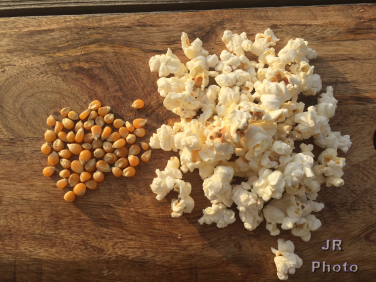Popcorn makes a fun lesson for food science and you can explore lots of food knowledge.
I know it’s not a healthy food, but that’s the point – let students discover its nutrition – mostly starch.
Here’s some activities you can investigate
- For teachers – what is the value of a lesson with popcorn?
- Find 20 popular products made from maize. Now plan a day’s meals and snacks with foods made from maize.
- Find the nutritional value of plain popcorn and then find health claims people are making
- What is the science behind popped corn? Look at popping kernels then look at popped corn and work it out!
- How much does it cost? Compare supermarket sites for cost 100g. Where does it come from?
- Get hold of a bag of cinema popcorn and fill it with popcorn you have made – work out how much it has cost.
Nutrition of cinema popcorn
I can’t find the weight of Cinema popcorn but here’s some nutrition data from The Odeon – fascinating reading.
Sweet popcorn – small 318 kcal 15g sugar 3.5 tsp sugar
Sweet popcorn – medium 522 kcal 26g sugar 6 tsp
Sweet popcorn – large 816 kcal 40g sugar 9 teaspoons sugar
Salt popcorn – small 357 kcal 0.48g sugar 0.7g salt
Salt popcorn – medium 609 kcal 1.2g salt
Salt popcorn – large 812 kcal 1.6 g salt
Small coke 195 kcal, 48g sugar (11 tsp)
Small fanta 195 kcal, 48g sugar (11 tsp)
Large coke 390 kcal, 97g sugar (22 tsp)
World Health Organisation suggests we cut sugar to 5% daily intake.
That’s about 25g (around six teaspoons) for an adult of normal weight every day.
A teaspoon of sugar weighs 4.4g so
The large popcorn bags are intended for sharing but are often eaten by just one person.
Make your own popcorn in a microwave
Ingredients
10g popping corn
Equipment – clear plastic food container with lid, plate
Method
Put the popping corn in the food container and put lid on top.
Cook in the microwave for 1 minute. Some kernels may begin to pop. Removed the popped ones and microwave for a further minute.
Remove the popped kernels and heat the remaining ones again. You will find that some do not pop – this is because they are too hard and dry.
Take care when you open the lid as the steam is hot.
Now think of the science – the kernel is heated and the water in the kernel heats and turns to steam.
The starch in the kernel gelatinises with the water and expands and the steam and the cooked starch explode outside the kernel.
This bursts the grain and the starchy gooe turns inside out and the protein in the maize coagulates forming the popcorn.
- Heat the oil in a large, thick bottom saucepan.
- Put 4-5 popping corns into the oil and when they pop, add the remaining corns.
- Cover with a tight fitting lid and remove from the heat. Count to 30 – this brings all the corns to the right temperature ready for popping.
- Put the pan back on the heat with the lid on – you can hear the corns popping.
- Leave the lid slightly open to allow steam to escape.
- When the popping begins to stop, remove from the heat and put the popped corn into a bowl.
- Remove any unpopped corn – these are very hard and can break your teeth.
- Popcorn needs to be eaten soon after it is made – or store in a closed plastic bag for a short time.
Flavour the corn with salt mixed with finely ground spices such as smoked paprika, cumin and coriander.
Sweet popcorn can be tossed with icing sugar and cinnamon.

